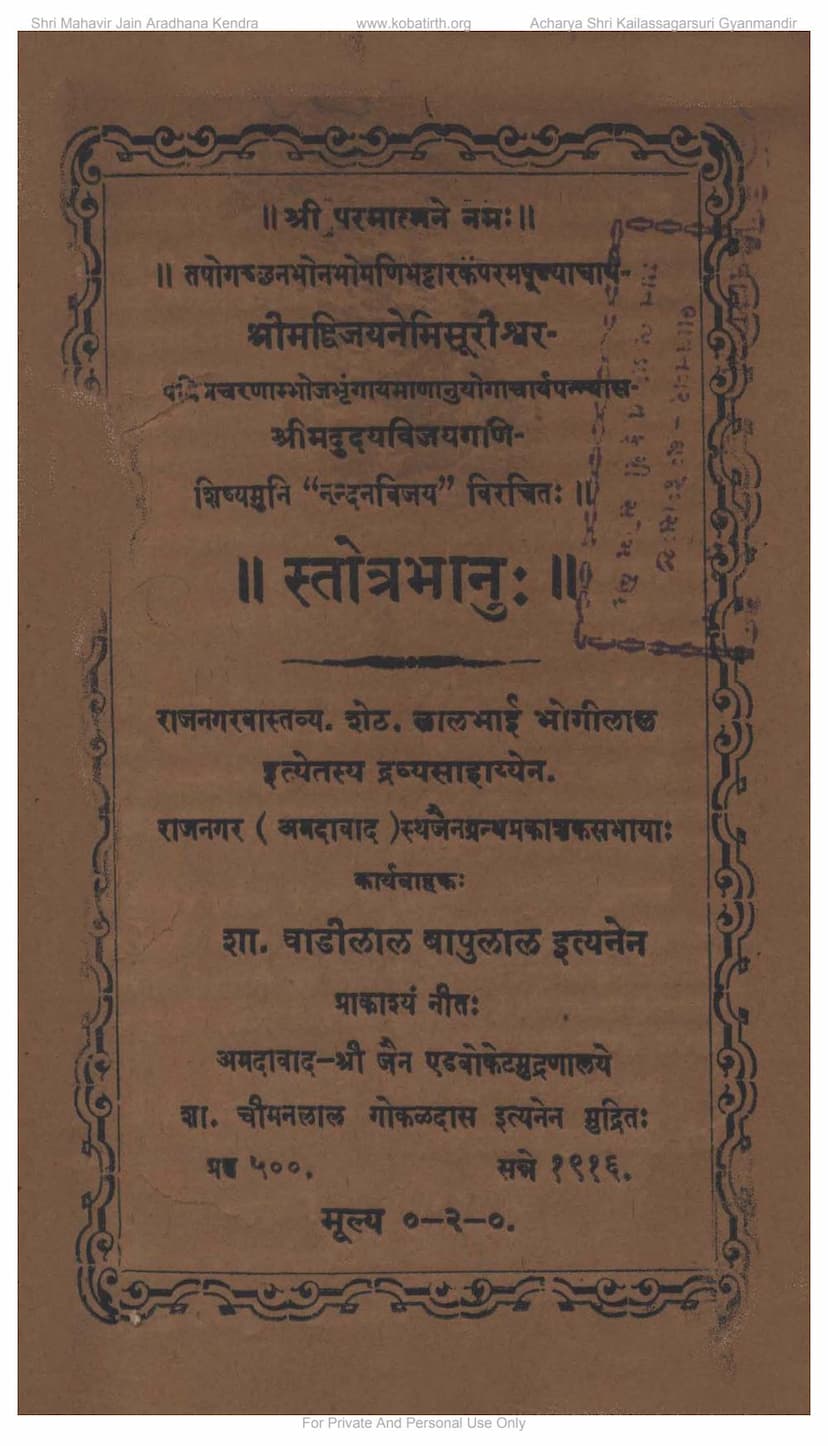Stotrabhanu
Added to library: September 2, 2025

Summary
Here's a comprehensive summary of the Jain text "Stotrabhanu" by Nandanvijay, based on the provided pages:
Title: Stotrabhanu (स्तोत्रभानुः) Author: Muni Nandanvijay (मुनि "नन्दनविजय") Publisher: Jain Granth Prakashak Sabha (जैन ग्रन्थ प्रकाशक सभा) Location: Rajnagar (Ahmedabad) (राजनगर (अगदावाद)) Year of Publication: Vikram Samvat 1972 (स. १९७६ - likely a typo and refers to 1972 as per the last page note) Price: 0-2-0 (This is an old currency value)
Overall Nature of the Text:
"Stotrabhanu" is a collection of hymns (stotras) primarily dedicated to glorifying the Tirthankaras (Jain spiritual teachers) and important Jain figures, particularly the Acharyas. It is written in Sanskrit, with verses structured in various poetic meters. The text is characterized by its devotional and reverential tone, aiming to inspire spiritual reflection and devotion.
Key Content and Structure:
The book is a compilation of various stotras, including:
-
Introduction (प्रस्तावना):
- The introduction, presented by the Jain Granth Prakashak Sabha, states that this small book of hymns to the Dev (God/Tirthankaras), Guru (Teachers), and deities is being offered.
- It highlights the author, Muni Nandanvijay, as a disciple of Anuyogacharya Gyani Panyasji Maharaj Shri Udayvijay Gani, who is in turn a disciple of Acharya Shri Vijay Nemisurishwarji Maharaj.
- It mentions the author's background as a merchant's son from Bhavnagar, Saurashtra, and his adherence to the monastic path for many years.
- The author humbly requests forgiveness for any perceived lack of ornamentation or imagination in his new work, attributing its creation to divine inspiration and offering "mithyā-duskr̥t" (a form of penitence) for any errors.
- A plea is made to the readers for forgiveness for any mistakes due to visual impairment or printing errors.
-
Stotras (Hymns): The main body of the book consists of numerous stotras, each typically praising a specific Tirthankara or a group of Tirthankaras, and also important Jain Acharyas. The stotras are composed in various Sanskrit poetic meters, such as:
- Vasantatilaka (वसन्ततिलका)
- Shardulavikridita (शार्दूलविक्रीडितम्)
- Shikharini (शिखरिणी)
- Totaka (तोटकम्)
- Anushtubh (अनुष्टुब्)
- Vanshasthavrutta (वंशस्थवृत्तम्)
- Drutavilambita (द्रुतविलम्बितम्)
- Shalini (शालिनी)
- Bhujangaprayata (भुजङ्गप्रयातम्)
- Arya (आर्या)
- Upajati (उपजातिः)
- Vaitaliya (वैतालीयम्)
- Harini (हरिणी)
- Mandakranta (मन्दाक्रान्ता)
- Rathoddhata (रथोद्धता)
- Indravajra (इन्द्रवज्रा)
- Malini (मालिनी)
The stotras consistently praise the Tirthankaras for their divine qualities, their role in guiding humanity, their victory over passions and karma, and their attainment of liberation (moksha). Common themes include:
- Omniscience (Sarvajna): Being all-knowing and seeing all things.
- Deliverance from Suffering: Guiding beings across the ocean of worldly existence (samsara).
- Purity and Virtue: Upholding righteous conduct and detachment.
- Destroyers of Ignorance and Passion: Conquering internal enemies like anger, ego, deceit, and greed.
- Auspicious Attributes: Mentioning their physical characteristics, divine emblems, and the blessings they bestow.
-
Chaitra Vandanāni (Vandanas to Temples/Idols of Twenty-Four Tirthankaras): The book features a significant section dedicated to "Chaitra Vandanāni" (श्रीचतुर्विंशतिजिनचैत्यवन्दनानि), which are hymns specifically for venerating the temples or idols of each of the 24 Tirthankaras. Each Tirthankara is praised individually.
-
Stotras to Specific Acharyas:
- Shri Vijay Nemisurishwar (श्री विजयनेमिसूरि): There are extensive stotras dedicated to Acharya Shri Vijay Nemisuri, highlighting his spiritual prowess, leadership, deep knowledge of scriptures, and his role in propagating the Jain Dharma. The "Shri Vijay Nemisuri Panchavishantika" (श्रीविजयनेभिमुरिपञ्चविंशिका) and "Shri Vijay Nemisuri Dvātrinsikā" (श्रीमत् परमगुरु विजयनेमिरिद्वात्रिंशिका) are notable sections focusing on him.
- Shri Guruvargas: There's also a section titled "Shrimad Gurvashtakam" (श्री मद्गुर्वष्टकम्), which is a set of eight verses praising the guru in general, emphasizing virtues like renunciation, adherence to Dharma, knowledge, conduct, penance, detachment, and wisdom.
-
Specific Stotras:
- Adinath Stuti (आदिनाथस्तुतिः): A praise for the first Tirthankara, Adinath (also known as Rishabhanatha).
- Shanti Nath Stuti (श्रीशान्तिनाथस्तुतिः): A praise for the 16th Tirthankara, Shantinatha.
- Nemi Nath Stuti (श्री नेमिनाथस्तुतिः): A praise for the 22nd Tirthankara, Neminatha.
- Parshvanath Stuti (श्रीपार्श्वनाथस्तुतिः): A praise for the 23rd Tirthankara, Parshvanatha.
- Mahavir Jin Stuti (श्रीवर्द्धमान जिनस्तुतिः): A praise for the last Tirthankara, Mahavir (also known as Vardhamana).
- Shri Bhuvana Deepak Stotra (श्रीभुवनदीपकस्तोत्रम्): This title is mentioned but its full content isn't explicitly detailed in the provided pages.
Author's Dedication and Intent:
The author, Muni Nandanvijay, dedicates this work to his spiritual preceptors and the Jain community. He expresses humility and a sincere desire to spread devotion and knowledge through these hymns. The text reflects a deep reverence for the Tirthankaras and the learned Acharyas who have preserved and propagated the Jain teachings.
Key Figures Mentioned:
- Muni Nandanvijay: The author.
- Acharya Shri Vijay Nemisurishwarji Maharaj: The grand-preceptor of the author.
- Anuyogacharya Panyasji Maharaj Shri Udayvijay Gani: The author's direct guru.
- Tirthankaras: All 24 Tirthankaras are praised, often individually.
- Gautam Swami: A prominent disciple of Lord Mahavir.
Overall Significance:
"Stotrabhanu" serves as a devotional text within Jainism, offering a collection of verses that celebrate the spiritual achievements and virtues of the Tirthankaras and leading Jain gurus. It is a testament to the rich tradition of Jain devotional literature and the veneration of spiritual guides. The work aims to uplift the reader spiritually and foster a deeper connection with the Jain path.
The "Shuddhipatra" (Errata) at the end indicates a careful review and correction of printing errors, showcasing a commitment to accuracy in the presentation of the text.